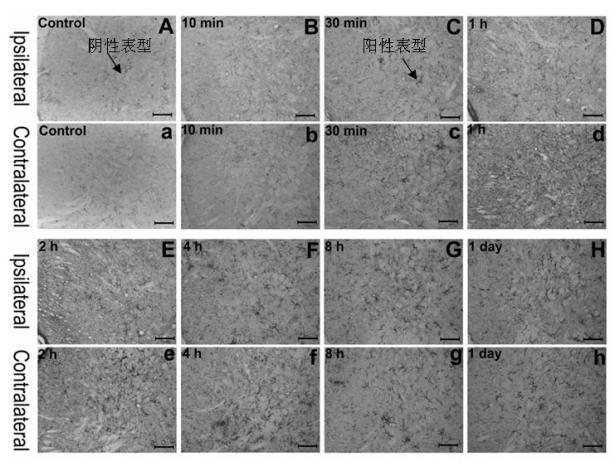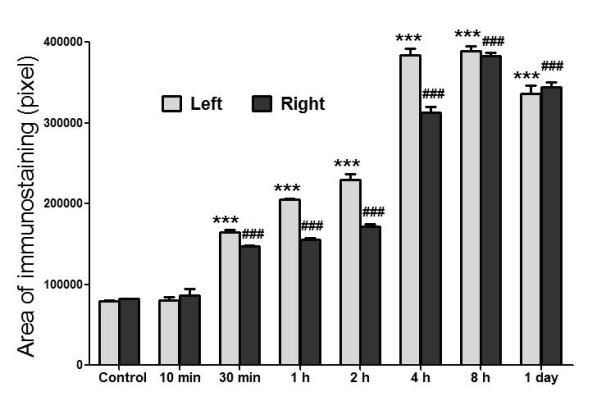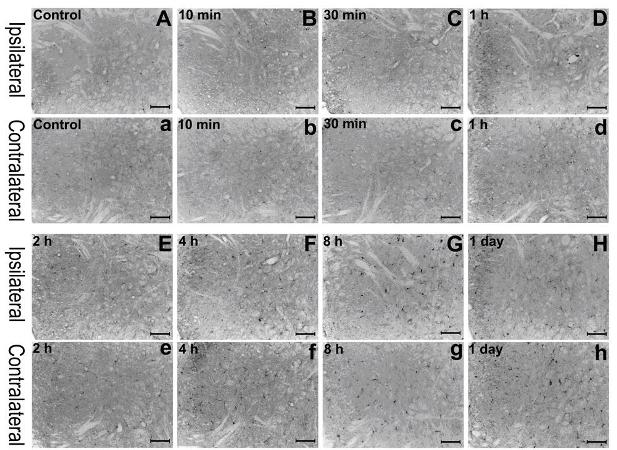Application of inhibitor SB (Sodium Butyrate) 203580 of p (phosphor) -p38
A technology of p-p38 and inhibitors, applied in the direction of anti-toxic agents, anti-inflammatory agents, non-central analgesics, etc., can solve problems such as unclear activation of microglial cells
- Summary
- Abstract
- Description
- Claims
- Application Information
AI Technical Summary
Problems solved by technology
Method used
Image
Examples
Embodiment 1
[0021] Example 1: Activation time course of microglial cells in rat L4-L5 spinal cord in BmK I pain model
[0022] Rats were subcutaneously injected with BmK I, then deeply anesthetized with pentobarbital sodium (60mg / kg) and then perfused. First, inject 200ml of normal saline from the ascending aorta, and then replace it with 400ml of 4% paraformaldehyde (dissolved in 0.1M PB buffer, pH=7.4). The lumbar spinal cord at the corresponding time point was fixed with the above formaldehyde solution for 12 hours, and then dehydrated with 20% sucrose PB solution (the tissue should sink to the bottom), and finally repeated tissue dehydration with 30% sucrose PB. Then the tissue was frozen into slices (thickness 14um) and pasted on the plectrum for experimentation. The "avidin-biotin-peroxidase (ABC)" method was used for immunosingle labeling. First, the sections were infiltrated with PBS buffer (0.01M, pH=7.4), and then incubated with the primary antibody (48 h, 4°C ), secondary...
Embodiment 2
[0024] Example 2: Time course of expression of p-p38 in L4-L5 spinal cord in BmK I pain model.
[0025] See the introduction in Example 1 for the slice preparation and result analysis methods. Note: The positive result counted in this implementation case is the number of p-p38 positive cells. The primary antibody used in this example is anti-p-p38 rabbit polyclonal antibody (1:200, CST Company), and the secondary antibody used is biotinylated goat anti-rabbit secondary antibody (1:200). see image 3 with Figure 4 .
[0026] The experimental results showed that in the spinal cord of the L4-L5 segment, the number of p-p38 positive cells was gradually activated with the establishment of the BmK I pain model, and reached a peak at 8 hours. This appears to be highly correlated with the activation time course of microglia. The above results suggest that the activated cellular localization of p-p38 may be associated with microglia.
Embodiment 3
[0027] Example 3: Cellular localization of p-p38 in the spinal cord
[0028] see Figure 5. Slice preparation refers to the method in the implementation case 1. In the fluorescence double-labeling test, the slices were first infiltrated with PBS buffer (0.01M, pH=7.4), and then incubated with the first primary antibody (24 h, 4°C) and secondary antibody (2 h, room temperature) before the second incubation. Two kinds of primary antibody incubation and secondary antibody incubation. Between the above incubation processes, rinse with PBS buffer three times, 10 minutes each time. Sections were observed under a microscope (Leica) after using glycerol slices. Immunofluorescence photos were synthesized with Image J image processing software. The primary antibodies used in this example include: anti-OX-42 mouse monoclonal antibody (CD11b, microglial cell marker, 1:50, Santa Cruz Company), anti-GFAP mouse monoclonal antibody (GFAP, star glial cell marker, 1:300, CST company),...
PUM
 Login to View More
Login to View More Abstract
Description
Claims
Application Information
 Login to View More
Login to View More - R&D
- Intellectual Property
- Life Sciences
- Materials
- Tech Scout
- Unparalleled Data Quality
- Higher Quality Content
- 60% Fewer Hallucinations
Browse by: Latest US Patents, China's latest patents, Technical Efficacy Thesaurus, Application Domain, Technology Topic, Popular Technical Reports.
© 2025 PatSnap. All rights reserved.Legal|Privacy policy|Modern Slavery Act Transparency Statement|Sitemap|About US| Contact US: help@patsnap.com



